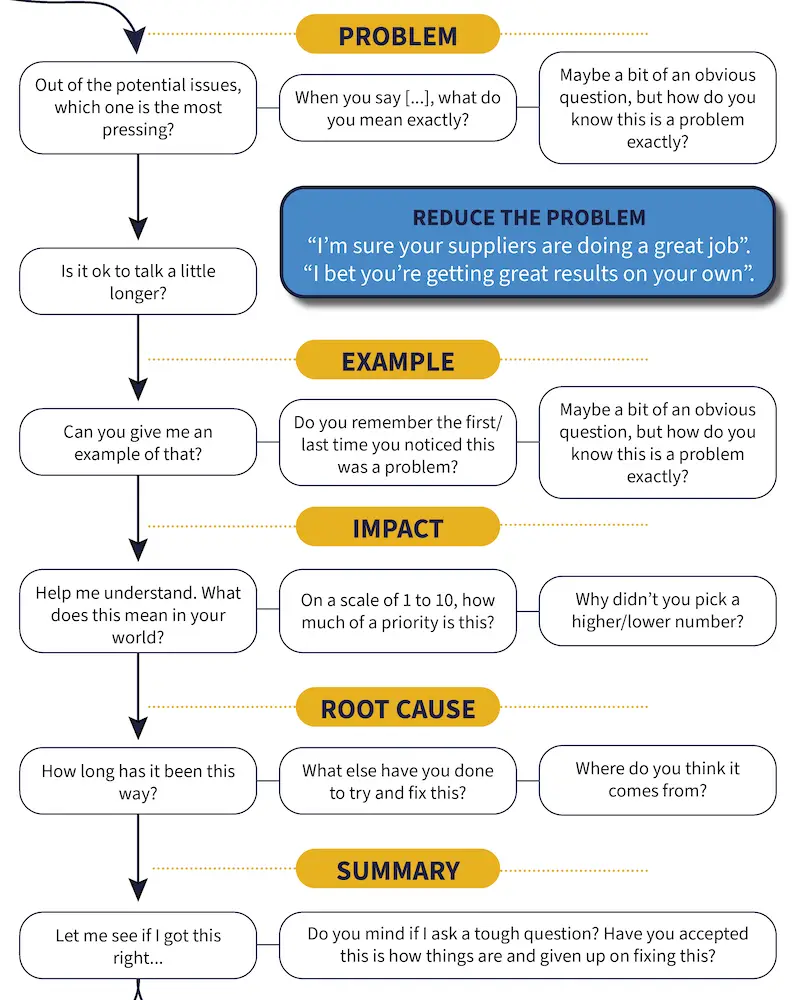❌ (Dis)qualifying prospects

Why Disqualify?
Most salespeople are so happy to talk to a prospect that they’ll ignore the red flags.
The same applies to dating – how often do you ignore signs because you don’t want to be alone?
This equates in:
- Time wasted
- Disappointed expectations
- Commission staying a dream
This is why it’s always better to attempt to disqualify the prospect.
If they have a problem/need, they’ll be the first ones to defend it passionately.
Let them do the work, and only put the “hot” prospects in your pipeline.
Qualifying the Problem
Let’s not forget the structure 👇🏻

It’s CRUCIAL that you stay on the problems for one simple reason:
This will keep them emotional.
People buy emotionally.
All these steps are there to keep the prospect focused on their favourite topic:
THEMSELVES.
Sadly, prospects won’t just sit and answer your questions (not always).
The two best ways to keep the conversation going:
Always useful:
Mirroring
If the prospect is explaining something emotionally charged:
Labelling
Finally, they may ask questions.
This is actually not good for you, it will give up control.
And you’re likely to start vomiting features about how great you are.
Try this instead:
Example
Even if you only care about booking meetings (which is terrible sales practice), you want to get an example of the problem.
Once you get the example, the problem is real.
DO NOT ASK FOR THE MEETING BEFORE.
A few questions you can use:
- When you say you’re experiencing {problem X}, can you give me an example of what it looks like in your company?
- You said you’re facing X; how does that look like in your world?
- Could you give me an example of {problem X}
No example = no problem.
If they can’t think of an example:
- It sounds like it’s not really a problem at all then.
They may come back swinging.
If the prospect is in a hurry, you may try to close: Closing
Impact
Don’t ask what the impact of the problem is; just don’t.
Instead, ask:
- What would happen if you just left things as they are?
- I don’t think it’s clear; what this mean for you?
- Why is this such a problem for you?
You can ask the prospect to scale the problem:
- Let me get this right: on a scale of 1 to 10, how much is this affecting the business?
You can then get them further emotionally by asking:
- Why didn’t you pick a lower/higher number?
All these questions aim to test whether the prospect truly cares about the problem.
They’re unlikely to give you time to fix it if they don’t get emotional.
This is when you can instead reduce the problem:
- It doesn’t sound like anything would change if things stayed as they are
- It sounds like you’re managing well anyway
- It feels like it’s not a big problem
All labelling questions. Stay neutral.
Again, if they’re in a hurry and get emotional, for: Closing
Root Cause
You may think, why the hell do I need the Root Cause?
Because people like to bitch and moan.
And then do absolutely nothing about their problems.
The deeper you go, the more likely they will buy, not just sit in a meeting.
This is why cold calling is unbeatable; you can’t get people invested via email.
You’ll want questions like:
- What have you done to fix this in the past? Why did it not work?
- Where do you think the problem comes from?
You may even suggest solutions yourself: have you tried x, y, z.
This will help you understand the true depth of the problem.
What you want to be careful about is:
- It’s always been this way
- It’s the way things are
- We’re used to it
Even if you do hear those, go to Closing
Struggling with Cold Calling?
Or join 300K Followers Social Media:
.svg)